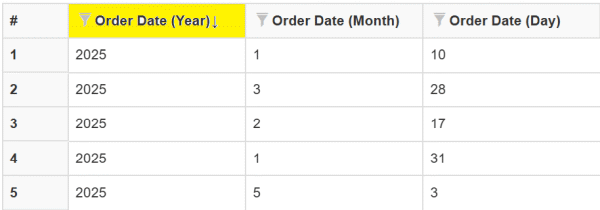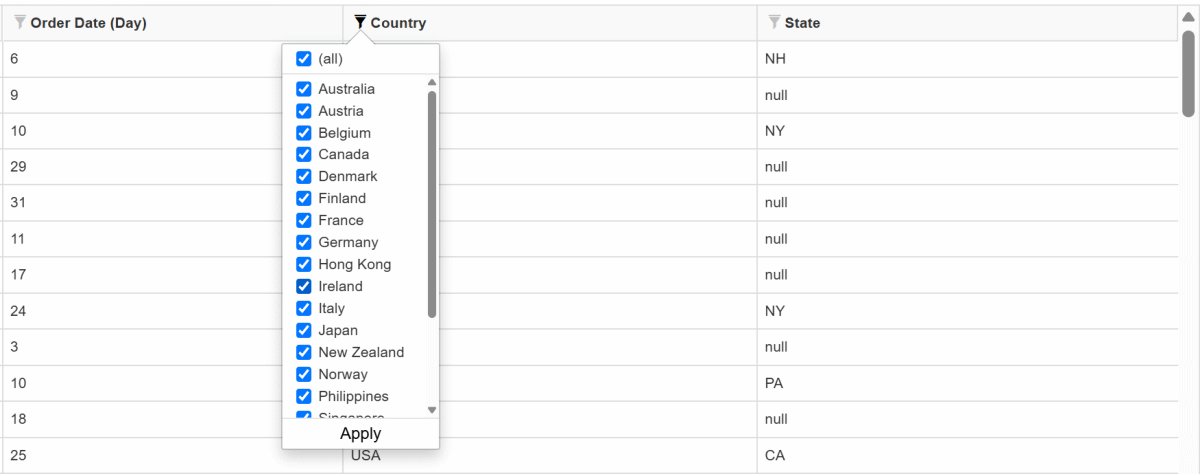How to create a Flat Table report
A flat table displays underlying dataset rows similar to an Excel-like "format as table" data grid view. Flat table reports are useful for basic analytics needs (like getting "last N orders", finding concrete customer's orders etc) and for the purpose of data validation. By presenting all the raw data in a single, comprehensive table view, a flat table allows analysts to quickly inspect the data, identify any immediate anomalies or inconsistencies.
Flat table reports are also highly practical for data export and transfer purposes. Their straightforward structure allows them to be easily exported into widely accepted file formats such as CSV or Excel. This makes them highly portable and facilitates seamless data sharing with individuals who may not have access to the BI tool or for further analysis using other software applications.
It is very easy to create a flat table in SeekTable:
- Connect to your data: upload a CSV file or setup a database connection.
- Add a new report: click "Create Report", or choose "+" next to cube's name in the left menu.
- Switch "Report Type" option to "Flat table"
-
Choose which columns to include into the report. Only cube's dimensions that are allowed for flat table report type can be selected.Hold CTRL to select multiple items at once. Click "add all" to show all available columns.
- Click the "Apply" button

|
→ |

|
Sort Flat Table
You can order table rows in the following ways:
-
 By column: to order rows by the column just click this column's header.
To change order direction click this header again:
By column: to order rows by the column just click this column's header.
To change order direction click this header again:
- ← indicates A-Z order (ascending)
- → indicates Z-A order (descending)
- By multiple columns: click near Columns to open a dialog where you can choose a complex sorting criteria.
Filter Flat Table
You can exclude / show only certain rows in the same way as you can do that in Excel:

Note that checkboxes reflect only values that are shown in the table (or values that where excluded explicitely, see below). If some items are filtered, the "(all)" checkbox will be in an indeterminate state (neither unchecked nor checked); you can quickly remove all filters of the column by checking "(all)".
In addition to that, you can manually enter filtering conditions in the Filter textbox:
- Keywords for the same columns are combined with OR. To force AND use
+to combine conditions:price>>50+price<100 - To match a substring (like) use
column_keyword:prefix, for example:contact:John. Prefix should match at least one column's label.
For exact matches use=comparison:country=Germany.
For number-type dimension it is possible to specify a comparison with a number:year>2020. - To match a phrase use quotes:
name="John Smith" - To exclude matched items use
-prefix, for example:-country=Venezuela. - To filter rows with
NULLvalues:-country=null

Another way to filter report's data are report parameters. With report parameters it is possible to filter by columns that are not included into the report.
Report parameters may be configured only explicitly in the cube configuration form; please check your data source type help page for guidance. Params tab appears when at least one report parameter is configured for the cube.
Cells Selection
In SeekTable, you can select cell contents of one or more cells in the same way as you do that in Excel:

- To select a range, select a cell, then with the left mouse button pressed, drag over the other cells.
- To select non-adjacent cells and cell ranges, hold Ctrl and select the cells.
Similarly, you can unselect selections: hold Ctrl and click the selected cell. - If all selected cells belong to the same column, you can choose all cells of this column by clicking "Select all cells of the column".
- When at least one cell is selected, you can copy selection to the clipboard by pressing Ctrl+C (Cmd+C).
- When 2 or more cells are selected, a tooltip displays some info about selection like in Excel: Count (the number of non-empty selected cells), Average and Sum (only if all cells contain numbers).
Cells Formatting
You can specify custom columns headers and custom format for values in this way:
- Click the "gear" icon near Columns.
- In this dialog you can specify report-specific column labels (headers) and width (in "%" or "px").
-
Specify a custom format for an appropriate item with this pattern:
<prefix> {value_format_specifier} <suffix>wherevalue_format_specifiercan be:For numbers formatting meaning of#→ display only integer part
$#.##→ display numbers as "$50.01" (empty if zero)
$0.00→ display numbers as "$50.01" ("$0.00" if zero)
yyyy-MM-dd→ display dates as 2019-07-15
MMM→ format a month number (1-12) as a short month name (Jan, Feb etc)
MMMM→ format a month number (1-12) as a full month name (January, February etc)
ddd→ format a day-of-week number (0-6) as a short day-of-week name (Mon, Tue etc)
dddd→ format a day-of-week number (0-6) as a full day-of-week name (Monday, Tuesday etc)
0.#|k→ if number>1000 shorten it with "k" suffix
0,.0#→ show number in thousands (value divided by 1000)
0.#|kMB→ shorten large number with an appropriate "k"/"M"/"B" suffix
#,0,.,,is the same as in Excel. For complete reference on the format syntax see .NET String.Format documentation.

Exports
SeekTable can export flat tables to all popular export formats:
- 100% the same as report's web view (custom HTML formatting is preserved), long tables are correctly exported to multiple PDF pages.
- Excel
- Layout is the same as report's web view. Formatting, cells colors and links are exported too.
- CSV
- A text file with comma-separated values.
Suitable for huge exports (million+ rows)on-prem SeekTable only. - HTML
- Raw HTML
<table>that can be used anywhere. - Image
- Available in API / published reports.
- JSON
- Available in API / published reports.
Suitable for huge exports (million+ rows)on-prem SeekTable only.
By default exports include only data that you see in a web view (the current page only, if pagination is used). If you want to export all rows/columns you may check Export all data option, and in this case export will include as much rows as possible (up to 50,000). This limit can be increased in self-hosted SeekTable.